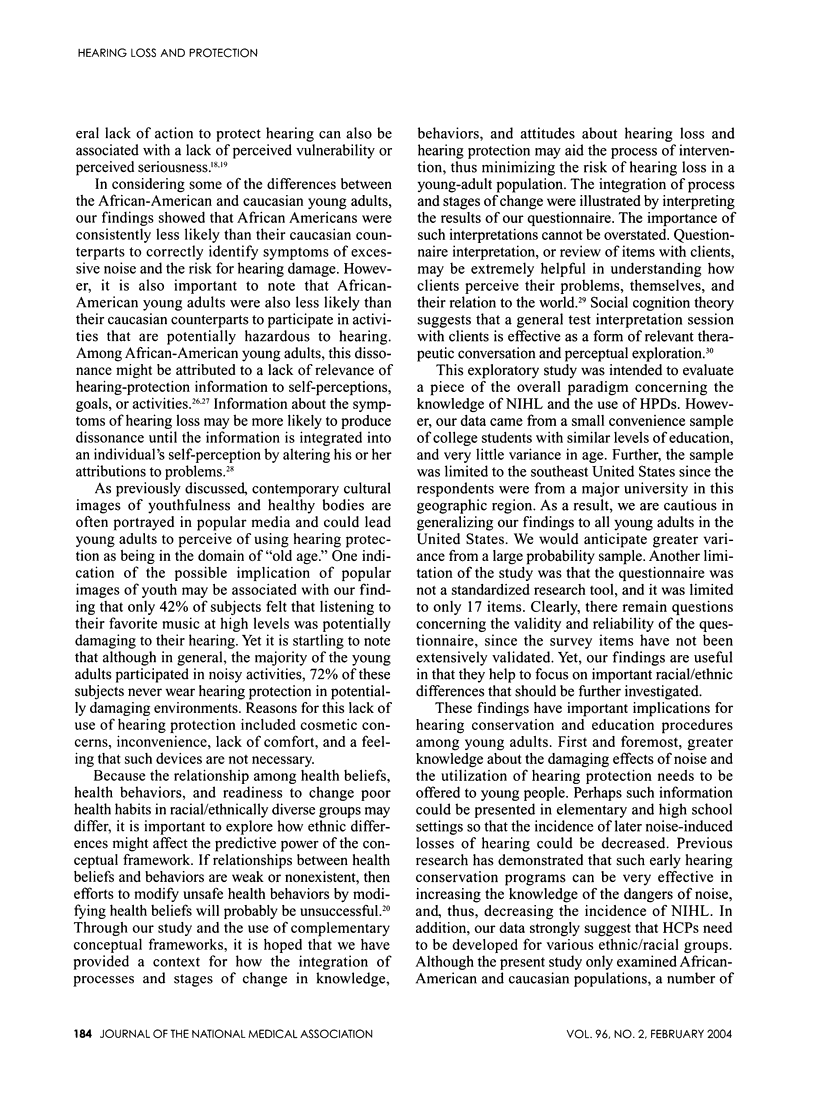Abstract
Over 11 million individuals exhibit some degree of permanent noise induced hearing loss (NIHL). Despite such data, there remains a paucity of empirical evidence on the knowledge of noise exposure and hearing protection devices (HPDs) for young adults, particularly those of diverse racial/ethnic backgrounds. This lack of research is unfortunate, as prior research suggests that the incidence of NIHL can be reduced through educational programs, such as hearing conservation programs (HCPs). Moreover, research also indicates that such educational programs are more beneficial when developed for specific age and/or ethnic/racial groups. The primary aim of this investigation was to determine the knowledge base of 200 college-aged young adults aged 18-29, concerning the auditory mechanism, NIHL, and the use of HPDs. The second aim of this study was to identify race and ethnicity differences or similarities in knowledge of these areas among African-American and caucasian young adults. Overall, in many instances, a majority of the young adults in our study demonstrated a high degree of knowledge concerning factors associated with exposure to excessive noise and the risk of hearing loss. Yet, the results also revealed significant racial/ethnic differences in knowledge, behaviors, and attitudes about the use of HPDs. Recent estimates suggest that more than 11 million individuals in the United States exhibit some degree of NIHL. Moreover, 40 million individuals work in environments that contain potentially harmful noise levels, and over 50 million Americans routinely use firearms--a common cause of noise-induced hearing impairment. A specific hallmark manifestation of NIHL is a permanent decrease in hearing sensitivity from 3,000-6,000 Hz, with a characteristic notch at 4,000 Hz. Additional effects of exposure to high noise levels include physiological changes in heart rate and blood pressure, decrease in work productivity, and an interference with communication that results from the masking of speech. With these considerations in mind, the purpose of this study was to investigate the knowledge, behaviors, and attitudes of a young-adult population in the United States concerning the factors that contribute to NIHL and the use of hearing protection. Additionally, this study was interested in whether there were racial/ethnic differences or similarities in knowledge of hearing loss and the use of HPDs among African-American and caucasian young adults.
Full text
PDF










Images in this article
Selected References
These references are in PubMed. This may not be the complete list of references from this article.
- Becker M. H., Maiman L. A., Kirscht J. P., Haefner D. P., Drachman R. H. The Health Belief Model and prediction of dietary compliance: a field experiment. J Health Soc Behav. 1977 Dec;18(4):348–366. [PubMed] [Google Scholar]
- Brookhouser P. E., Worthington D. W., Kelly W. J. Noise-induced hearing loss in children. Laryngoscope. 1992 Jun;102(6):645–655. doi: 10.1288/00005537-199206000-00010. [DOI] [PubMed] [Google Scholar]
- DiClemente C. C., Prochaska J. O., Fairhurst S. K., Velicer W. F., Velasquez M. M., Rossi J. S. The process of smoking cessation: an analysis of precontemplation, contemplation, and preparation stages of change. J Consult Clin Psychol. 1991 Apr;59(2):295–304. doi: 10.1037//0022-006x.59.2.295. [DOI] [PubMed] [Google Scholar]
- Gochman D. S. The organizing role of motivation in health beliefs and intentions. J Health Soc Behav. 1972 Sep;13(3):285–293. [PubMed] [Google Scholar]
- Prochaska J. O., DiClemente C. C., Norcross J. C. In search of how people change. Applications to addictive behaviors. Am Psychol. 1992 Sep;47(9):1102–1114. doi: 10.1037//0003-066x.47.9.1102. [DOI] [PubMed] [Google Scholar]
- Rosenstock I. M. Why people use health services. Milbank Mem Fund Q. 1966 Jul;44(3 Suppl):94–127. [PubMed] [Google Scholar]
- Sokas R. K., Moussa M. A., Gomes J., Anderson J. A., Achuthan K. K., Thain A. B., Abu Risheh Z. Noise-induced hearing loss, nationality, and blood pressure. Am J Ind Med. 1995 Aug;28(2):281–288. doi: 10.1002/ajim.4700280212. [DOI] [PubMed] [Google Scholar]
- Wilde G., Humes L. E. Application of the articulation index to the speech recognition of normal and impaired listeners wearing hearing protection. J Acoust Soc Am. 1990 Mar;87(3):1192–1199. doi: 10.1121/1.398793. [DOI] [PubMed] [Google Scholar]





